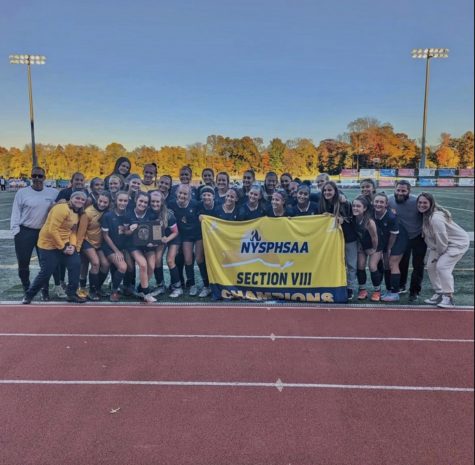Signs, silence, and suspension: the MHS walk-out situation
Usually known as Pi Day, this year March 14 held another purpose to high school students nationwide. It marked the one month commemoration of the shootings that took place at Marjory Stoneman Douglas High School in Parkland, Florida.
Inspired by the Women’s March Youth EMPOWER movement, students across the country planned to walk out of their classes at precisely 10:00 o’clock in the morning in order to speak out against school violence and commemorate the victims that died in Florida. The mission was to have seventeen minutes of silence for the seventeen victims who lost their lives in the Parkland shooting. With school officials working with student leaders to coordinate the events of the day, some students felt the school’s plan was not enough.
“Congress must take meaningful action to keep us safe and pass federal gun reform legislation that addresses this public health crisis,” said The Women’s March Youth EMPOWER Movement’s website, regarding the school walk-out.
Massapequa High School officials, including principal Mr. Patrick DiClemente, organized “Moments of Remembrance: A Day of Peace.” The school offered students the option to “walk-out” and proceed to the track area behind the school, or to remain in their fourth period class.
“I really appreciate that there were a lot of people together [in the back]..,” Mr. DiClemente said, “…this was something that demonstrated that people want to affect people beyond themselves outside the community.”
However, 32 students chose to demonstrate in the front of the building to honor the victims of Parkland in their own way. Approximately 50 other students attempted to exit through the front doors, but school administrators as well as security guards blocked the students from exiting.
The students who demonstrated in the front of the building sat in a circle near the flagpole in silence for seventeen minutes, reading off a name of each of the victims each minute. The students in the back of the school walked around the track and held signs to spread a message of change and peace.
“We wanted to gain attention for the movement and support our fellow students. For many, that did not seem achievable in the back,” junior Patricia Taylor said.
Mr. DiClemente made an announcement before the walkout started, specifying that students who carried political posters and/or congregated in the front of the building would face disciplinary action. But, only the students that congregated in the front of the school received punishment.
Many people questioned the decision to only penalize students that met in the front of the building and not those who carried political posters in the school endorsed “Day of Peace”.
“I don’t think I could say to anyone that you can have any sign you want in school, just like you could [not] play any music you want. I can’t say that in my position, it’s not appropriate here,” Mr. DiClemente explained, “What I can say is you’re welcome to have a sign and have an opportunity to speak. But there are some signs or some speech that needs to be censored because of our setting.”
This could be due to the 1965 Supreme Court case Tinker v. Des Moines—where in students wore black armbands with the peace symbol to protest the Vietnam War.
This case helped set the precedent for future student-lead demonstration and established a precedent that “students rights are not shed at the schoolhouse door.” The Supreme Court ruled that public schools could not limit student’s First Amendment rights unless it significantly disrupted the educational process.
“I think a lot of what happened too is that the school tried to stifle the meaning of what it is too much, and that’s kind of setting a poor precedent for things happening in the future that are lead by students and it’s just not going to give them the incentive to continue doing things like this if their voices aren’t going to be heard,” senior Evan Warns said.
Students who chose to demonstrate in front of the building were given an opportunity to reconsider their decision and join their classmates in the back of the school. It was reiterated by administration that disciplinary action would be put in place if they left.
Similarly, Connetquot students received in school suspension (ISS), which followed the school policy of violating the school code of conduct. Students across LI were not punished for exercising their first amendment right, but rather for not following school rules and the code of conduct.
Other students on Long Island faced consequences for leaving to the front of their schools as well. Each school’s code of conduct dictated the severity of the punishment.
The students that demonstrated in the front of the school spoke in front of the Board of Education (BOE) on March 15 in order to appeal their ISS.
Students like Patricia Taylor, presented their case in front of the Board, “it almost felt like we were hiding in the back…” Taylor said during her speech. “…we honored those kids who do the same thing we do [everyday], we go to school, we try to get an education, we try to figure out our futures…”
After a tense meeting, with arguments from both sides presenting their case, district officials decided to uphold the decision to give the students one-day ISS, with no record on their transcripts, and no penalty to National Honor Society.
During the meeting, Mrs. Iconis read a statement that cited the reason the students would receive the suspension. “We could not support a walkout in which our students left class to congregate without supervision outside of the school building.”
“Contrary to the letter issued today [March 15] by Governor Cuomo, students were not suspended here in Massapequa for exercising their first amendment right, but rather for failing to comply with the direction of our teachers, administrators, or security,” Mrs. Iconis said in her statement.
According to Newsday, in a letter to the state Education Commissioner, Ms. MaryEllen Elia, Governor Andrew M. Cuomo stated that “threatening to discipline students for participating in the peaceful demonstrations is not only inappropriate, it is unconstitutional…”
The high school Dean’s office declined to comment on the ISS decision.
Numerous parents, both of the students involved and those of younger students voiced their concerns and opinions. The general consensus, from the parents and other community members at the meeting, was the students who met in the front of the building were receiving too harsh of a punishment for their actions.
“What the district has decided, along with the Board, is this would be insubordination, that’s the charge from the code of conduct. What happens with insubordination is that they receive one day of in school suspension. The reason the Board took this stand is because it’s very difficult to not apply here…” Mrs. Iconis added.
While parents, students, and school officials disagree on how the walkout was handled, the shooting in Parkland, Florida has had a profound effect on the nation including students and faculty. The walk-out has given students the voice to speak out about a sensitive topic and to promote change on a state and national level.









